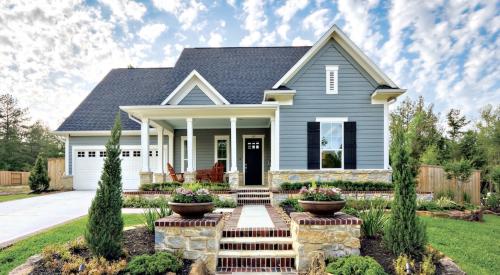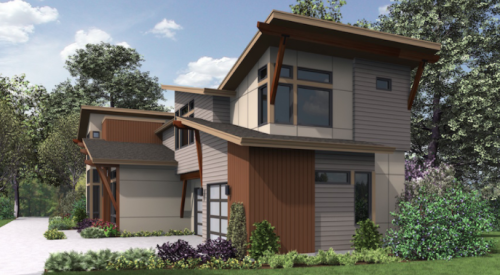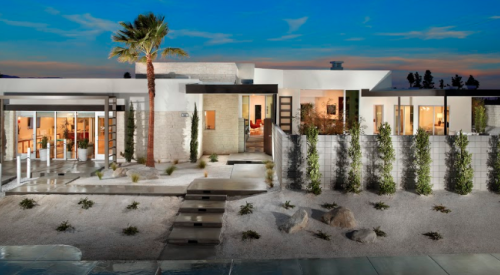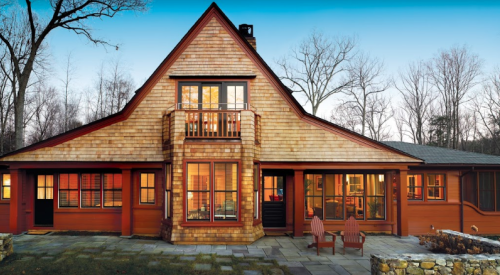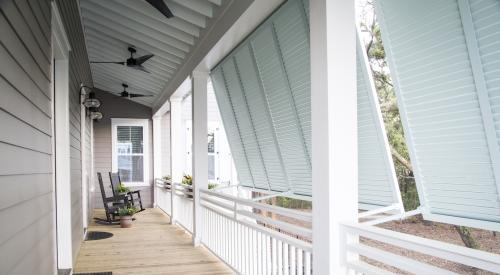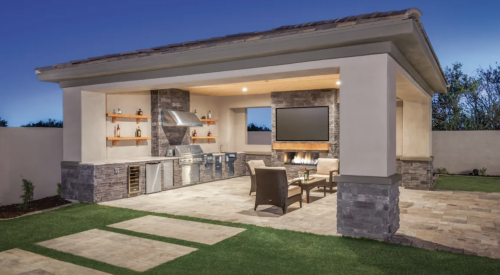| Across the country, outdoor living is in. Fireplaces, water features, sitting and entertaining areas - even outdoor kitchens - bring the inside out.
|
Maybe it’s getting a little late in the year to be listing trends for 2001 - and perhaps naming trends of the New Millennium is already a little blasé. Nonetheless, builders and architects are talking about what’s new - as well as what’s holding its ground - in residential design.
Today’s educated, savvy buyer profile, combined with limits in lot size, increased competition amongst builders, the desire to differentiate - and did I mention the Internet-cruising, ultra-savvy buyer? - mean that home builders’ attention, more than ever, is focused on design.
Exteriors
Although certain areas of the country have their own, very distinct vernacular when it comes to design, California architect Mark Sheurer insists, "Good design is not regional." But creating good design is an intensive process and one that requires a great deal of forethought.
Call it reminiscence or merely a recognition of what works - and what sells - but there has been a definite return to architecture of old. Today’s home buyers yearn for the houses of yesterday - if only in look and feel. Sheurer says the key for builders who want to successfully use historically inspired architecture is to choose to either replicate the style or interpret it, and then make sure it’s well-executed.
Some builders have success merely pulling notable exterior details from certain styles, like broad gables or stout porch columns to lend the air of the Craftsman style, for instance. In this case, less really is more, and a mish-mash of styles doesn’t really work. Middleburg, Va., architect Russell Versaci says people don’t want "architectural gumbo," they want "homes with character, both inside and out." Buyers are looking for an authentic precedence, he says, so it feels like their home fits in.
With the look back in time comes the rising trend of putting porches back on homes. The Neotraditional school says that front porches maximize outdoor living opportunities and neighborly interaction, but they also afford homeowners a certain level of privacy if they are set at the right height - about head level of passersby on the street.
Courtyards, too, are very popular - and not just in the Sunbelt. Bonita Springs, Fla., builder Dan Sater says even in colder climes, like Michigan, where he’s building a lakefront custom home, beautiful outside "rooms" are highly desired. "After a cold, harsh winter, spending time outdoors in the spring, summer and even the fall is that much more important."
Perhaps the exterior development gaining the most steam is the de-emphasis of the garage. Be it alley-loaded rear-entry, side-entry or merely pushed back from the front of the house, the dominance of the garage is starting to wane and more street-friendly front elevations are emerging.
Even with that desire for less prominent garages - on the part of consumers and communities alike - there has been an increase in the desire for more garage space. When one or two-car garages don’t cut it, innovations such as tandem garages or a motor court set-up (with two side-entry garages flanking a home’s entrance), are answering the call for solutions.
Floor Plans
| Historical details, like the roofline and stout columns indicative of the Craftsman style shown here, give a home a sense of authentic precedence.
|
Except for small shifts here and there, the basic American floor plan really hasn’t changed much over the years. The great room seems to be nudging out separate living and family rooms, and kitchens have increased significantly in size, not to mention scope of activity, but for the most part shifts have been more evolutionary than revolutionary.
A notable addition to floor plans, however, is the designated space for a home office - or even two, his and hers. As the telecommuting and self-employment trend continues, so does the need for a proper place to work at home. The convertible spare bedroom/den combination no longer suffices; home offices are becoming more elaborate, sometimes with separate entrances, and still others are separate from the home altogether - the California casita comes to mind.
The recognition that the American family is changing has altered floor plans somewhat as well. Master bedrooms on the first floor are a common response to aging boomers’ and seniors’ desires to age in place. And, although bedroom counts have not increased significantly, in some markets - especially those with high Asian populations - housing allows for the probability that an extended family might live under one roof.
Interiors
Buyers want homes that look different from everyone else’s, that seem like they were created exclusively for them. Variety in elevations is important, but homeowners want the insides of their homes to feel unique as well. Interior details like moldings and trim pieces, arches, beams, built-ins and niches, even if they are part of a standard or upgrade package within a production product line, allow homeowners to feel their home is personalized for them. "People are looking for much richer finishes - and by that I don’t mean more expensive, just more detailed," says Versaci, who sees this attention to interior details occurring at almost all price points and markets.
There is also a very consumer-driven shift to more variety in flooring. Although carpet and tile still dominate, more and more builders are moving to hardwoods of every species and configuration and natural stone. Especially in open floor plans, builders are using continuous flooring throughout the home to tie the rooms together. Westchester, NY, architect Andrew Chary says he even carries stone floors on out to patio areas to blur the lines between indoor and outdoor living.
If flooring is used for the appearance of continuity, in other cases ceiling details can provide a sense of distinct living areas. Coffered, cathedral or other ceiling details, as well as variations in ceiling heights, help to break up the monotony of standard height ceilings. Ceiling variations can be especially effective in small floor plans or long and narrow configurations. Along the same lines, a couple steps down into the living room or up to the master bedroom suite go a long way towards breaking up a boring plane.
Ultimately, when it comes to implementing new design ideas and trends, every builder’s experience is different. Sometimes bold and different sells well, but at other times subtle signature touches may take a builder far in his or her market. Sheurer’s reminder is that "simple doesn’t mean boring."
